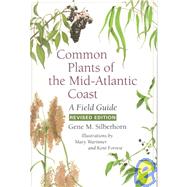Common Plants of the Mid-Atlantic Coast : A Field Guide
, by Silberhorn, Gene M.; Warinner, Mary; Forrest, Kent- ISBN: 9780801860812 | 0801860814
- Cover: Paperback
- Copyright: 3/23/1999
Beggar's ticks and marsh pink. Tearthumbs and chairmaker's rush. Live oak, pitch pine, wild black cherry, sassafras, and loblolly pine. From eelgrass rooted in wrack lines on windswept back shores to hardy maritime forests sculpted by strong winds and salt spray, the Mid-Atlantic coast is rich with a variety of habitats and an abundance of common, if not always familiar, plants. In "Common Plants of the Mid-Atlantic Coast," Gene M. Silberhorn provides a field guide to the plants found along the coast from Long Island Sound to North Carolina's barrier islands. This introduction to the fragile ecology and remarkable beauty of the flora of the coastal region was highly praised by reviewers when it was first published in 1982. This revised edition retains the features that earned it acclaim and provides a wealth of new information. The three sections of the book correspond to the natural divisions of the landscape: Section One covers beaches, dunes, and marine forests; Section Two includes salt and brackish marshes; and Section Three reviews plants found in tidal and nontidal freshwater wetlands. Each section of Common Plants begins with an introduction that describes the characteristics of the area and the flora to be found there. Individual plant entries follow. Delicate illustrations accompany facing page descriptions that aid in identification and provide concise background information, as well as delightful anecdotes. Plant entries now includes the subheadings: "Growth Habit and Diagnostic Characteristics," where the reader will find descriptions of general appearance, "Distribution," which tells where along the coast the plant is found, "Habitat," and, particularlyimportant in this age of heightened environmental awareness, "Ecological Value/Benefits." The author has also added each plant's "Wetland Indicator Status," which estimates a species' frequency of occurrence in wetland habitats. Seve






